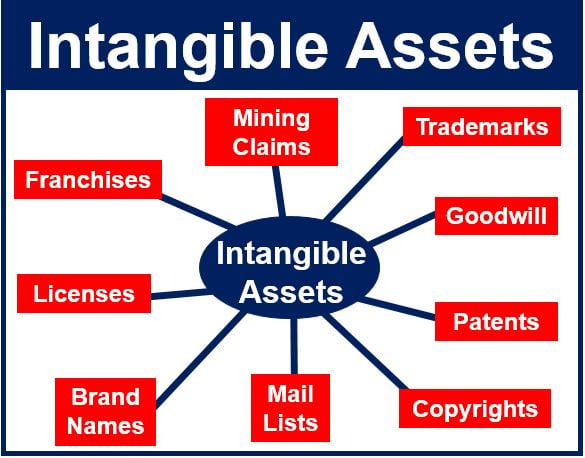Intangible Assets are assets that have no physical form, i.e., you cannot touch them. Hence, they are very difficult to evaluate. However, businesses consider them as valuable resources.
If something is “tangible,” it means that you can touch it. You can touch, for example, a car, table, or person. If something is “intangible,” it means that you cannot touch it. You can’t touch an idea, reputation, or feeling of happiness.
Intangible assets contrast with tangible assets, which are assets that we can touch; they have physical form. There are two types: fixed assets (land, machinery, equipment, buildings, and vehicles) and current assets (cash, stocks).
Examples
Examples of intangible assets include franchises, mining claims, licenses, brands, and copyrights. Goodwill, trademarks, mail lists, and patents are also examples. Other people cannot usually use them unless they pay for the rights.
Intangible assets are extremely hard to value accurately because there is usually nothing equivalent to compare them to. Their true value may differ considerably from the amount on the balance sheet.
Knowledge capital, i.e., ideas, methods, and other intuitive talents that a business owns, are also things we cannot touch.
The British Government (HM Revenue & Customs) defines intangible assets as: “Non-financial fixed assets that do not have physical substance but are identifiable and are controlled by the entity through custody or legal rights.”

Trademarks and trade names that the workforce developed internally may not appear on the balance sheet. However, they may be worth more than any other asset the company has.
Trademarks are words, phrases, signs, symbols or designs. They distinguish and identify the source of the goods or services of one party from those of others.
Don’t ignore intangible assets
Despite having no intrinsic value, we should not ignore intangible assets. Above all, we mustn’t ignore them when working out net debt to group shareholders’ funds. We must not ignore them because they are worth something to a business.
Beware of intangibles that exceed or make up most of a company’s overall assets, say some expert investors.
Although intangibles are generally long-term assets, some of them such as trademarks and patents are categorized as ‘fixed intangible assets’ (and not just ‘fixed assets’).
Definite and indefinite intangible assets
There are two types of intangibles: indefinite and definite.
-
Indefinite intangible asset
A business’ brand, if it originated within the company, carries on as long as the company continues operating.
-
Definite intangible asset
If a business paid to use a brand name that belongs to another company and has no plans to extend the agreement, that asset will not be part of the company forever.
Goodwill is a vital component for increasing a commercial enterprise’s customer base – it also attracts investors.
Some companies’ brand names are worth billions of dollars. For example, the brand name of Apple Inc. was estimated to be worth more than $128 billion by brandirectory.com.
Vocabulary and concepts related to intangible assets
There are many terms in business English related to “intangible assets.” Below are some such compound nouns, their meanings, and examples of how to use them in a sentence:
-
Intangible Asset Valuation
The process of determining the value of non-physical assets.
Example: “The company underwent an intangible asset valuation to assess the worth of its brand and intellectual property.”
-
Intangible Asset Management
The administration and optimization of non-physical assets.
Example: “Effective intangible asset management is crucial for maximizing the company’s market value.”
-
Intangible Asset Accounting
The process of recording and reporting intangible assets in financial statements.
Example: “Intangible asset accounting requires careful consideration to ensure compliance with financial regulations.”
-
Intangible Asset Amortization
The systematic reduction of the recorded value of an intangible asset over time.
Example: “The software’s cost was spread out through intangible asset amortization over five years.”
-
Intangible Asset Acquisition
The process of obtaining non-physical assets, either through purchase or development.
Example: “The merger included an intangible asset acquisition, adding significant value to the company’s intellectual property portfolio.”
-
Intangible Asset Depreciation
A reduction in the value of intangible assets over time due to factors like obsolescence or legal expiry.
Example: “The company’s patents are subject to intangible asset depreciation as they near their expiration dates.”
-
Intangible Asset Protection
The legal and strategic measures taken to safeguard non-physical assets.
Example: “Our firm specializes in intangible asset protection, particularly for intellectual property rights.”
Video – What are Intangible Assets?
This video presentation, from our sister channel on YouTube – Marketing Business Network, explains what ‘Intangible Assets’ are using simple and easy-to-understand language and examples.
